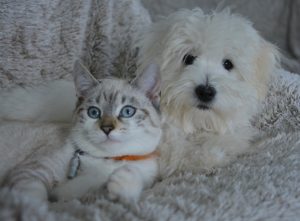
Your home is just an extension of your kitty’s kingdom… at least, that’s how your feline friend sees it. Your adult cat is used to being the star of the show, whether he or she loves lounging on the arm of the sofa, climbing up their cat tree or jumping out of boxes and bags to “scare” everyone else in the family.
But now, you’re ready to add a puppy into the mix. And despite the fact that you’ve seen dozens of Instagram accounts of dogs and cats cuddling adorably, you know that this arrangement will take some acclimation.
Here are four ways to help your new puppy and adult cat bond when you’re ready to test the “opposites attract” theory in your own home.
Start with Scents
Before you allow your new puppy and your resident cat to see each other face to face, get them used to one another’s scents. Start by bringing your new canine companion into a designated room with a closing door while giving your adult cat control over the rest of the house. Keeping a door between them for safety, allow these two pets to smell and hear the other. You can even place an article of clothing containing the puppy’s scent outside the room and something smelling like your cat in the puppy’s playroom.
Make Slow, Careful Introductions
Now it’s time to bring sight into the equation. Using a barrier (like a baby gate) and a leash for your puppy, introduce your animals into communal space to see how they react. You’ll want to have a handful of treats on hand to reward your puppy for engaging in curious, calm and restrained behaviors around the cat. This way, he or she will create positive associations with your other animal.
This process may take several days, with each face-to-face session extending slightly longer until your animals are accustomed to acting comfortable around each other.
Give Each Pet Their Own Space
One huge potential for conflict is your animals fighting over space. Remember, your cat is used to its environment; a new interloper (no matter how cute or enthusiastic) may be cause for anxiety and stress. Make sure that both your pets have distinct eating, sleeping and recreation areas so they have fewer reasons to clash.
Before you bring home your new bundle of fur, you’ll want to pick up the essentials: dog beds on sale (to create a few sleeping areas throughout the house), food and water bowls and chew toys. Likewise, you’ll want to make sure your cat has its own food and beverage bowls out of your dog’s reach, plus a few places to perch up high for security. Your kitty will also need a place to sharpen her claws—one that isn’t your poor puppy’s muzzle!
All in all, it’s important to create distinct dining, sleeping and relaxing areas for each pet. This way, they both have a claim on their part of your home and nobody feels left out. It will also discourage meandering, whether it’s your puppy getting a little too curious about the litter box or your cat deciding to sample your dog’s food.
Reward the Right Behaviors
Positive reinforcement is key when it comes to introducing cats and dogs. Your actions will teach your dog how to interact with your other pets, which is why you should reward obedience like sitting, lying down and coming when called during introductions. It’s tempting to punish bad behavior, but this builds negative associations in your pooch’s mind about being around your cat, which may spike anxiety or frustration. Positive reinforcement, on the other hand, helps guide your dog toward learning a highly desirable set of behaviors that will make the introductions much easier!
These four ways to help your new puppy and adult cat bond should start introductions off on the right foot. The key is giving each animal the space and equipment it needs to thrive and taking things slowly so no mishaps occur. Before long, your pets will tolerate one another (and maybe grow to become best friends).























